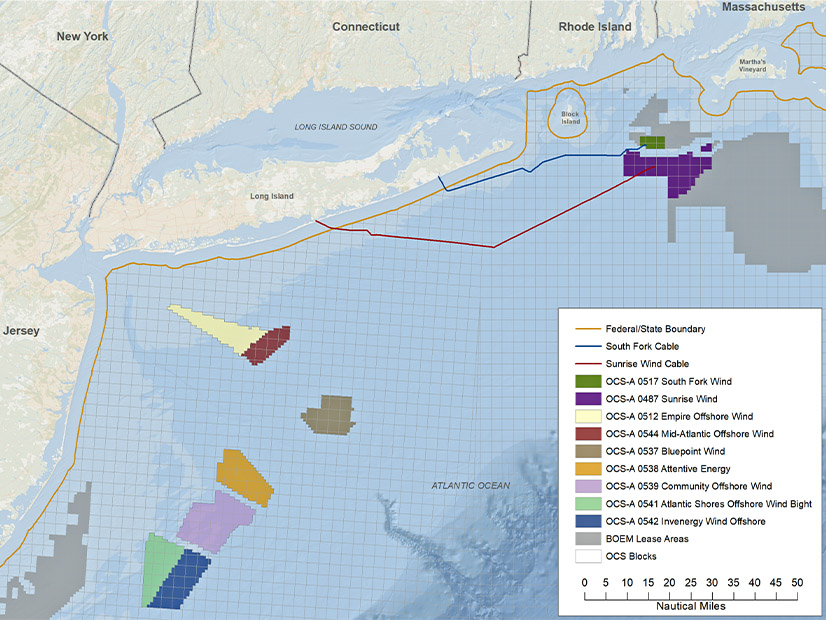
Federal regulators have completed their environmental analysis of plans for Empire Wind, finding potentially significant impact on the fishing industry and endorsing some changes to the 2.1-GW offshore wind farm proposal.
The Bureau of Ocean Energy Management on Monday released its final environmental impact statement for the proposal.
Publication of the EIS typically is one of the final steps in the review process. It’s the third EIS that BOEM has published in the past four months for a major offshore wind project; the previous two were followed five to six weeks later by records of decision approving construction and operation of Ocean Wind 1 and then Revolution Wind.
Empire Wind is a joint venture of Equinor and BP that would stand as close as 12 nautical miles south of New York and 17 nautical miles east of New Jersey. New York State has contracted with it to deliver 816 MW and 1,260 MW in Phase 1 and Phase 2, respectively.
Impact Statement
The details differ, but the final EIS announced Monday for Empire Wind reaches conclusions similar to EIS reviews prepared recently for other projects. They offer an often-wide range of possible outcomes for the criteria examined.
Empire Wind is expected to have minor to moderate beneficial effects on air quality and economics, for example.
It’s expected to have minor to moderate adverse effects on environmental justice communities and vessel navigation.
The effects on birds could be adverse or beneficial, or both.
The EIS also looks at the results of not building Empire Wind — the effects of climate change continuing unchecked as fossil fuels are burned to generate the electricity the offshore wind turbines otherwise would produce. In this no-action scenario, the adverse impacts on birds or people or fish often are projected to be of a similar magnitude even as the specific details are different.
But one thing is consistent in every EIS: the impact on the Northeast fishing industry.
BOEM forecasts Empire Wind will have a minor to major adverse effect on fishing, depending on the type of vessel and the species it’s harvesting.
Combined with the other 19 offshore wind farms that potentially could stand between Cape Cod and Cape May, the cumulative impact on commercial and for-hire recreational fishing is expected to be major.
For Empire Wind’s lease area OCS-A 0512, the greatest commercial impact is expected to be on the scallop fishery. Most of the area produced more than $4,000 worth of sea scallops per square kilometer per year from 2008 to 2018, and the harvest in a large swath exceeded $8,000 mean annual value.
Other major adverse impacts from Empire Wind are projected on the view from shore, search and rescue operations, and scientific surveys. Adverse effects on the critically endangered North Atlantic right whale could range from negligible to major.
Changes
Empire Wind 1 was proposed to have up to 57 turbines and Empire Wind 2 as many as 90. Their rotors would reach as high as 951 feet above sea level. They would be served by two offshore substations and up to 260 miles of inter-array cables. Up to 67 miles of export cable would run to landfall points in Brooklyn and farther east on Long Island.
However, after the draft environmental impact statement was published, Empire and BOEM conducted further analysis of glauconite soils in the lease area. Monopile foundations are so difficult to drive into glauconite that Empire concluded 40 of its potential turbine sites might not be viable. This cut the maximum number of turbines to 138.
Meanwhile, BOEM endorsed four changes to the routing and construction technique of the export and onshore cables.
BOEM has gathered these changes into a “preferred alternative”; it is the option the agency is leaning toward as it moves to its final Record of Decision.
Headwinds
Empire Wind is in line to be the fifth utility-scale offshore wind farm green-lighted in U.S. waters. The first two, Vineyard Wind and South Fork Wind, are under construction.
But Ocean, Revolution and Empire all have significant cost and supply challenges to overcome before they can start construction, as do other developers in the new U.S. offshore wind sector.
Equinor and BP have told New York they may not be able to proceed with Empire without substantially more money than was agreed upon.
Ørsted is seeking more money for Ocean and Revolution before it makes a final investment decision and has pushed the completion date for Ocean back a year.
Developers of two of Massachusetts’ three contracted offshore wind facilities are paying $100 million in penalties to back out of their power purchase agreements in hopes of bidding back into the Bay State’s latest solicitation at higher costs.
Earlier this summer, Orsted’s proposal for Revolution Wind 2 was rejected as too expensive in Rhode Island. And New York has invited bidders in its latest offshore solicitation to resubmit bids with lower price tags.


